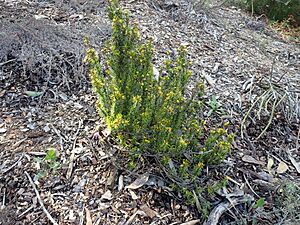Verticordia staminosa facts for kids
Quick facts for kids Verticordia staminosa |
|
|---|---|
 |
|
| V. staminosa subsp. cylindracea var. erecta leaves and flowers | |
| Conservation status | |
| Scientific classification | |
| Genus: |
Verticordia
|
| Species: |
staminosa
|
Verticordia staminosa is a beautiful flowering plant that belongs to the myrtle family, called Myrtaceae. It grows only in the south-west part of Western Australia, meaning it is endemic there.
This plant is a shrub and comes in two main types, or subspecies, with one of those having two varieties. All three types are quite rare and have been officially listed as "Threatened." You can easily spot Verticordia staminosa because of its long, noticeable stamens. These parts stick out far beyond its feathery yellow sepals and petals.
Contents
What Does This Plant Look Like?
Verticordia staminosa is a shrub that can grow to different heights. Some types reach about 20 to 60 centimeters (8 to 24 inches) tall, while others grow to 30 to 100 centimeters (12 to 39 inches). Its branches feel a bit bristly.
The leaves are long and thin, like cylinders. They are smooth, meaning they have no hairs (this is called glabrous). Each leaf is about 7 to 14 millimeters (0.3 to 0.6 inches) long.
The Flowers of Verticordia staminosa
The flowers grow where the upper leaves meet the stem (this spot is called an axil). Each flower sits on a small stalk, about 4 to 6 millimeters (0.16 to 0.24 inches) long. The base of the flower, called the floral cup, is shaped like half a ball and is about 2 millimeters (0.08 inches) long. It has small bumps but is also smooth.
The sepals, which are like small leaves protecting the flower, are feathery and spread out. They are 5 to 7 millimeters (0.2 to 0.28 inches) long. At first, they are lemon-yellow, but they later change to a reddish color. The petals are similar in color and length to the sepals. They stand upright and are divided into many feathery, finger-like parts.
The most special part of this plant is its stamens. These are the parts that produce pollen. They are joined together at their bottom end, forming a tube. The stamens are quite long, 6 to 12 millimeters (0.24 to 0.47 inches), and they alternate with much shorter parts called staminodes. The style, which is part of the female reproductive organ, is straight and smooth, measuring 7 to 12 millimeters (0.28 to 0.47 inches) long. This plant usually blooms from July to October.

How This Plant Got Its Name
The plant Verticordia staminosa was first officially described in 1963. Two botanists, Charles Gardner and Alex George, wrote about it after a sample was collected near Wongan Hills by Harry Butler. Their description was published in a science journal.
The second part of its scientific name, staminosa, comes from the word "stamen." This name was chosen because of the plant's very noticeable and long stamens.
Different Types of Verticordia staminosa
When Alex George looked closely at the Verticordia group of plants in 1991, he identified three different forms of Verticordia staminosa:
- Verticordia staminosa subsp. staminosa: This type has stamens that are 9 to 12 millimeters (0.35 to 0.47 inches) long.
- Verticordia staminosa subsp. cylindracea var. cylindracea: This is a shrub with branches that spread out wide. Its stamens are shorter, about 5 to 6 millimeters (0.20 to 0.24 inches) long.
- Verticordia staminosa subsp. cylindracea var. erecta: This type is an upright shrub with leaves that look like pine needles. Its stamens are also 5 to 6 millimeters (0.20 to 0.24 inches) long.
Where Does This Plant Grow?
Verticordia staminosa likes to grow in the soil found in cracks on exposed granite rocks.
- The staminosa subspecies is only found in one place, the Wongan Hills.
- The cylindracea variety grows between Newdegate and Pingaring.
- The erecta variety is found in a small area north-west of Newdegate.
This plant is also known as Wongan verticordia. There are only about 1,200 of these plants known to exist. Even though many new seedlings grow each year, the plant remains rare. Scientists believe its rarity is due to changes in the climate and more frequent fires in its habitat.
Why Is This Plant Protected?
All three types of Verticordia staminosa are listed as "Threatened" by the Western Australian Government's Department of Parks and Wildlife. This means they are in danger of disappearing forever, and efforts are being made to protect them.
Can This Plant Be Grown in Gardens?
Verticordia staminosa can be grown from cuttings. When first planted in a garden, they might grow slowly during their first year.


